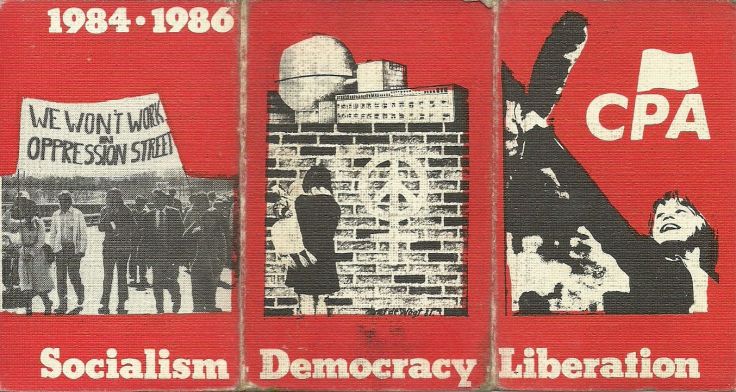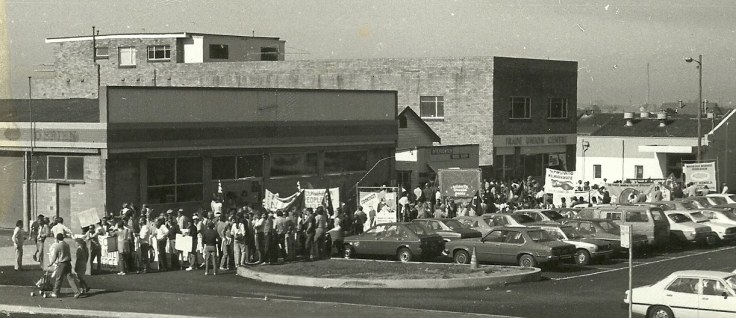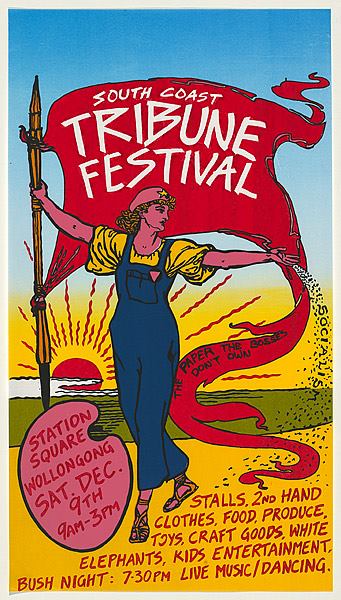On Thursday 24 March 2016 I interviewed my friend and comrade Nick Southall about some of his experiences as a young activist in the Communist Party of Australia in the late 1970s and early 1980s. In the interview we touch on a number of themes including Nick’s early involvement in the Young Communist Movement, his years as a full-time party cadre, tensions within the party between the national leadership and the South Coast District and the party’s relationship with international communist and resistance movements and domestic social movements. Where many histories of the CPA focus on machinations at the national level, Nick’s story reveals a living organisation with deep roots in the Wollongong labour movement and community that functioned as a family, if at times a dysfunctional one.
I have edited the transcript for clarity and length with Nick’s approval. – Alexander
Part 1 can be found here
‘I became a full-time party cadre’

Alexander
So around 15/16 you moved into full party membership or something along those lines. What changed. What did that involve?
Nick
Well for me it happened at the same time as I became a full-time party cadre. There was no being a party member and then just going along to branch meetings and being involved in the branch activities. As I recall it, I got my card pretty much at the same time as I left school and went to work for the party full time. I did become a member of the Wollongong branch, which was the major branch, but only one of a whole number of branches. I’m trying to remember how many branches. There was a university branch, the Wollongong branch, the industrial branch, the waterside branch, there was the mining branch, a Yugoslav branch. Was there another one? I think there was half a dozen branches. Anyway, I was in the Wollongong branch. So obviously I went along to branch meetings, but as a full-time cadre really I was involved in all of the activities of all of the branches in different ways and I was working under the direction of the organiser, who was Pete. We had a bookshop worker, Viv, who did the accounts and did all of the admin at the party rooms. So there was three of us there. The party had an office in town, next door to the Trade Union Centre. The front was the bookshop, then the office, then there was the printery on the side and then there was a small meeting room and the large Len Sutty hall at the back, where the major party activities would happen. So, I would work in the office helping out Pete with whatever, sometimes Viv with whatever. Obviously if people came in I’d be selling books and so forth. We’d go out and sell Tribune. We would produce party propaganda. There was an industrial bulletin, a waterside bulletin that came out, well the waterside bulletin came out every week, the industrial bulletin came out more irregularly than that. We would also put out miners bulletins. There was a whole range of activities we ran: fundraising stuff every week at the waterside pay line and at all the mine pay lines as well, which brought in a lot of money and we’d organise stuff around that. We had a press and I learned to operate the press. As time wore on, I became basically the printer. So I would do all of the party printing, all those bulletins and leaflets and whatever, on the offset press there. Occasionally I’d write for Tribune or write for the bulletins, the industrial bulletin or the waterside bulletin. But that was only occasionally. A lot of the stuff was just general stuff and Pete would say can you go and do this. We had a party car, a beaten-up V-dub, which was terrible because the handbrake didn’t work. When you drove out of the party offices, you were immediately on a hill, you didn’t have a handbrake. It taught me to drive, a bit. I mean I already had a license but still.

Alexander
So where was the bookshop? Are you talking about where the current trade union centre is?
Nick
It was in Lowden Square. So, the Trade Union Centre, I think is it still called Fred Moore House, where the [South Coast] Labour Council and so forth are now. That’s a new building, a relatively new building. In the ‘80s the old building was demolished. All the protests started there, out the front, same as they used to. They have for years. Lowden Square, that’s where the protest starts.
There was a building similar to that but smaller and next door was the party building, one storey. As I say, bookshop at the front and the Len Suttey hall was about half of it which was out the back. There was an alleyway between the car repair joint next door and the party rooms so you didn’t have to go through the bookshop and the offices to get into the hall you could just walk down the side. and so when there was stuff on, usually at night, or meetings on, you could just walk down the side and use the hall. Other groups would use the hall, it wasn’t just Communist Party stuff. Some of the organisations that were close to the party would use it, some trade unions would use it, some social events, Australia-Vietnam Friendship Society film nights, that sort of thing.
‘I got elected to the District Committee’
Alexander
All those different branches you just mentioned, Wollongong branch, industrial branches, waterside branch etcetera, how were they connected to one another?
Nick
They were connected in that there was a South Coast District Committee. Each branch had representatives on the South Coast District Committee and they would meet once a month. I think branches met weekly, maybe some not quite weekly, but I think that was the basic structure. Branches meet weekly and the District Committee meets monthly. That’s my recollection. Maybe I’ve got the time wrong there. Maybe it wasn’t that often, but that was the basic structure. The reps would go to the South Coast District Committee. They would say, oh this is what the branch is doing etc. etc. They would discuss what the whole district was doing together. They would then obviously get information from the National Committee which would say this is what we want you to do. They’d discuss it. That would then be sent back to the branch. Then the reps would come and say OK, this is what the District Committee is doing, this is what the National Committee is doing. That’s how the communication and representation worked.
Alexander
As a full-timer, did you attend those meetings of the District Committee?
Nick
I was elected to the District Committee at some stage. So, initially no, I didn’t, I was just involved in my branch. But I was elected to the District Committee after a year of basically showing them that I was more than just a young idiot. Not that I wasn’t a young idiot, but that there was more to me than that. That I was a serious, full-time party cadre. We had a District Conference and then District Conference would elect people to the District Committee so I got elected to the District Committee. But I’d go to other branch meetings with Pete because as the organiser he would go to all meetings and sometimes I’d go with him, depending on what was happening. Since they were in the building I was working in, it wasn’t like going off anywhere, they were all happening there. Maybe not the university one. Maybe the university one met at the university. I don’t remember going to those. Maybe they met at the university, but all the rest. There was also a women’s caucus. It wasn’t a branch but it sort of had a similar relationship in that reps from the women’s caucus would speak about the women’s caucus. Obviously there was women in the District Committee and they would be involved in the women’s caucus, at least some of them, maybe not all of them. And they would do a similar thing, report back and have …
Alexander
So members of that caucus were themselves members of another branch?
Nick
Yes, they were. So all the women in the other branches. and let’s face it, there weren’t a lot of women in the mining and industrial branches, but say the university branch and the Wollongong branch and so forth had a chance to meet together as women and then talk about things and communicate with the District Committee and the branches about these things.
Alexander
And they did meet as women exclusively.
Nick
Indeed they did. I didn’t go to the women’s caucus.
Alexander
Were you paid in some way as a full-time party worker?
Nick
I wasn’t, no. I was on the dole. Luckily for me the social worker at the Department of Social Security was a party member, so whenever they hassled me into looking for work more conscientiously or doing things that were going to take me away from my party work, she would tell them that they shouldn’t hassle me. She’d basically make sure that they left me alone so that I could do my party work. So that was very handy, to have her there.

Alexander
What about Pete as the main party organiser, would he have been paid?
Nick
Pete got something and Viv got something. They were older than me. It was a lot more difficult for them but they would have got something. But we are talking very, very little. As my printing skills got better I went to work a couple of days a week up at Spot Press, where they produced Tribune and so forth because the party was keen to get me more involved in that. They were basically training me up as a printing apprentice. Then they covered some costs, I think transport, maybe they got me lunch or something like that. That was up in Glebe. I would go up there a couple of days a week. I did it for a while but I didn’t really want to be a printer. I didn’t like travelling up to Sydney and I didn’t want a trade. I wanted to be a party cadre. When the party said this is what they wanted me to do I gave it and go and realised that it was just basically doing a normal type of job that anybody could have done, communist or not. They could have got somebody else to do it, obviously not as cheap as me. But it wasn’t what I wanted to do.
When I first arrived there was a big poster on the wall when I walked through the door, ‘Trot Guide’, and I’m like, ‘bloody hell’, the Party is really taking this sectarianism against the SWP [Sociaist Workers Party] fairly seriously! But it was literally just on the same road as the, what’s the big greyhound race track up there? It was actually a guide for the trotters. I did a double take. They did a lot of commercial work. Again, I was working sometimes on commercial stuff and it’s like, I know its bringing in money for the party and that’s important and whatever but I wanted to be a bit more hardcore than that. I saw myself as an activist, an organiser and a political cadre rather than a tradesperson.
‘There was a growing tension between the South Coast district and the national’
Alexander
I’m wondering what your relationship was with the party beyond Wollongong?
Nick
It’s funny because they seemed to me like different sorts of beasts in many ways. I was very happy to be a part of the party in Wollongong. After I had been in there a year or so, and became more conscious of what else was happening, became familiar with the local and really immersed myself in the local, I could broaden my horizons a bit more. I was brought more into the District Committee discussions and got onto a higher level of discussions about what was going on in the party and hear reports on the National Executive and the National Committee and start to think about those things. There was a division. This is the end of the 70s, beginning of the 80s. The general feeling in the District, and certainly amongst those I was working most closely with was that there was serious problems with the National Committee. That the divisions were growing again, as they had in the past. That there was some move to disband, disorganise or transform the party away from being a communist party. Most people in the South Coast were very resistant to this. As I became more able to participate in the party on a national level, or at least being aware of what was going on and intervene in it in different ways, there was a growing tension between the South Coast district and the national. I tended to agree with the majority on the South Coast. I had joined the communist party and I wanted it to be a communist party and I had a certain vision of what a communist party was and this was being now challenged by important people on the national committee. I felt fairly alienated and estranged from that and as I learned more, increasingly bitter about what was going on at a national level. I wasn’t alone down here. In fact, most people felt similarly and so there was increasingly a tendency to do our own thing and a feeling of we are the red centre of the party and that we needed to demonstrate ideologically and practically the superiority of our position over what seemed to be the emerging national majority position.
Alexander
Do you think that relationship had changed a lot because of the dissolution process, with the local party and the national party? Or was there always that tension?
Nick
I think there had been a period where there had been less tension. What had happened and what I wasn’t really thinking a great deal about when I first joined and my first couple of years in the party was the previous splits. That wasn’t really something that I knew a lot about because I hadn’t been in the country let alone in the party when that happened. Because enough time had passed that the comrades who had remained in the party after the splits really didn’t want to concentrate on that anymore. They had spent years having to deal with that and now they didn’t want to talk about it and so I didn’t hear a lot of talk about it. You would hear occasional things and there would be occasional discussions on and talks about the splitters and whatever. But the party had come through a rocky period. The 60s and the early 70s had been a very rocky period. So following the calming down after the split of the SPA, I think people generally felt fairly united, and having a common cause, because they had survived and stood together during the split. But after a few years that was starting to unravel because the unity and the commonality in the face of the pro-Soviet people who had left to join the SPA was, when it actually came to the crunch, fairly tenuous. They had that in common and they were united around that but on pretty much everything else there was all these divisions that as time went on became more and more obvious.
Alexander
Did you participate in any national forums of the CPA?
Nick
At this time there was more and more open discussions. The party was starting to open itself up to having public forums with other groups of the left to try to, to … I think the national leadership wanted to move away from being a communist party and be a left, a broad left party. That was their strategy, so they were trying to broaden out the involvement of ‘the left’ in party discussions. I took part in the prospects for socialism debate and various national discussions around those sorts of issues and I was elected as a delegate to one national congress. I’m trying to remember when that was, it’s early eighties anyway, where I was elected to actually go and take part in that. This was when the clash between those who wanted to maintain a communist party and those who wanted to basically fold as a communist party were coming to a head.
(to be continued…)